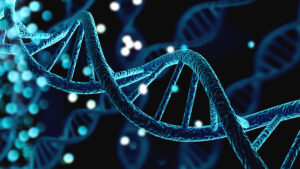February 14, 2024
Osteoporosis is a condition that affects the bones, making them weaker over time and more prone to breaking. The condition does this by causing a decline in bone mass and density. In other words, the bones become thinner and more fragile, losing what makes them strong.
Roughly 10 million Americans have osteoporosis.⁴ While anyone can develop a chronic condition, there are key factors that increase your risk. These factors include sex, age, race, and genetics. Explore how genes factor into your risk of developing osteoporosis, the early warning signs, and how to get diagnosed.
 Is osteoporosis hereditary or genetic?
Is osteoporosis hereditary or genetic?
When a condition or disease is considered hereditary, it has been inherited or passed down from parents to children through a mutation in their DNA. Not everyone who inherits the gene mutation will get the condition or disease, but they are at a higher risk.
If a condition or disease is genetic, it can be inherited through a mutation, or the mutation can occur at some point due to other factors.⁶ For example, if a person smokes, they could develop a gene mutation that leads to cancer. A mutation like this is not hereditary; it is considered an environmental factor.
Your risk of developing the condition increases if there is a family history of osteoporosis.² An inherited mutation would indicate that genetics are a factor in the development of osteoporosis. Genome-wide association studies (GWAS) discovered that having certain genes could be linked to a person’s risk of developing the condition.⁵ One study from 2018 suggests that genetic screening may be used to predict if a person is at future risk of osteoporosis.
Other non-genetic risk factors
While genetics play a large role in potentially developing osteoporosis, it is not the only factor. Typically, this condition has a combination of risk factors and causes that lead to reduced bone mass and, ultimately, osteoporosis.³
 Sex
Sex
While anyone can develop osteoporosis, a person’s sex is a risk factor. For example, women are at a higher risk than men. The higher risk is because women already have lower peak bone mass than men. In addition to that, when women go through menopause, their estrogen hormone levels decrease, which speeds up bone loss.
Age
Osteoporosis can develop at any age, but risks increase as you get older. According to the National Institute of Aging, your body naturally stops increasing bone mass around 30 years old. Due to this, you could be losing more bone mass than your body is replacing without even knowing it. By the time you reach the age of 50, you could be at greater risk of breaking a bone.
Race and ethnicity
While any race or ethnicity could develop osteoporosis, the condition is more common in Caucasian and Asian women and Caucasian men. Despite these findings, Black and Hispanic women still have a serious risk, according to the National Institute of Arthritis and Musculoskeletal and Skin Diseases.
 Lifestyle
Lifestyle
Lack of physical activity, especially weight-bearing exercises like weightlifting, walking, or running, can lead to weaker bones and a higher risk of osteoporosis. These types of exercises help trigger bone development and strengthen bone tissue.
In addition to a lack of regular exercise, smoking can increase your risk of developing osteoporosis. Smoking reduces bone development, affects your body’s ability to absorb calcium, and decreases estrogen levels in women.
Certain medications and conditions
Other medical conditions like hormonal disorders, celiac disease, inflammatory bowel disease, and rheumatoid arthritis can increase the risk of osteoporosis. Certain medications can also increase your risk, though the risk may be so small that it shouldn’t prevent you from taking it. Such medications include:
- Antiseizure medications
- Antacids containing aluminum
- Breast and prostate cancer medications
- Corticosteroids for arthritis, asthma, and other conditions
- Diuretics
- Depo-progesterone
- Heparin for blood clots
- Immunosuppressant drugs, like methotrexate
- Selective serotonin reputable inhibitors (SSRIs)
- Thiazolidinediones (TZD)
- Thyroid hormone medications
The risks of taking these medications apply mostly to their long-term use. If you are concerned about any risks associated with the medication you are taking, always consult your primary care physician, especially before ending treatment.
Prevention of genetic osteoporosis
Taking action to prevent developing osteoporosis is always helpful, even if the condition does not run in your family. Here are some easy ways to keep your bones strong and protected:
- Exercise regularly — weight-bearing and strength-training activities
- Eat a healthy diet, making sure you get enough calcium and vitamin D in the foods you eat, like
- Eggs
- Fruits
- Vegetables
- Whole grains
- Lean meats
- Yogurt and milk
- Nuts and seeds
- Quit smoking
- Limit your intake of alcohol
- Get enough sun exposure for vitamin D
Symptoms of genetic osteoporosis
A bone fracture is usually the first indication that you have osteoporosis because the condition can develop in your body without being noticed. Fortunately, there are some warning signs that you have low bone mass that could or already has developed into osteoporosis.
Potential early warning signs of low bone mass or osteoporosis:
- Breaking a bone, like your hip or wrist, in a minor fall
- Breaks that occur from normal movements like bending over or sitting down
- Loss of height
- Intense back pain
- Hunched or slouched posture
Since osteoporosis may be difficult to detect in its early stages, it’s important to take preventative actions to help strengthen bones and prevent breaks. If you experience any of these symptoms, talk to your primary care physician for a proper diagnosis.
Diagnosis of genetic osteoporosis
The best way to know if you have genetic osteoporosis is through a proper diagnosis by a healthcare professional. Due to the increased risk of age and sex, the U.S. Preventive Services Task Force (USPSTF) recommends screening for women over the age of 65 or if you have factors that increase your risk for osteoporosis. The Endocrine Society recommends screening for men over the age of 70 or as early as 50 years old if they have an increased risk for osteoporosis.
A diagnosis of osteoporosis involves a bone mineral density (BMD) test.¹ The test involves a dual-energy X-ray absorptiometry (DEXA) machine. The machine produces an image of your bone and soft tissue. The healthcare professional then compares the scan to an average, healthy 30-year-old adult.
The test uses a T-score to determine if the bone density is in the normal range. The T-score calculates how much the scan result is different from the average.
| T-Score | Result |
| -2.5 or lower | Osteoporosis |
| -1 to -2.4 | Osteopenia (low bone mass) |
| -1 to +1 | Normal |
Treatments for genetic osteoporosis
Once you have it, there is no cure for osteoporosis; there is only treatment to manage the condition and prevent breaks. This is why prevention is so important. Your physician may recommend certain lifestyle changes to prevent further bone density loss.
In addition to lifestyle changes like a healthy diet, regular weight-bearing exercise, and taking calcium and vitamin D supplements, other options for treatment could include:
- Estrogen replacement therapy: most often used for postmenopausal people)
- Physical therapy: to build strength and stability to prevent breaks
- Medications: bisphosphonates like Risedronate and Alendronate slow down bone loss
- Mobility aids: walkers, canes, or other aids to prevent fallsf
- Parathyroid hormone analogs: an artificial form of parathyroid hormone that helps regulate calcium distribution in the body.
Consult a healthcare professional
Early detection is key to managing osteoporosis. The sooner you know, the faster your physician can start treatment and prevent the condition from getting worse. Healthcare Associates of Texas has been helping their patients in the Dallas/Fort Worth community for 25 years. If you have any medical concerns and would like to be screened for osteoporosis, their expert staff can be there to guide and treat you.
Sources
- Cherney, K., & Collins, D. (2022, March 2). Osteoporosis and Genetics: Is There a Link? (A. Balingit, MD, Ed.). Healthline. https://www.healthline.com/health/is-osteoporosis-genetic
- Krista Conger. (2018, January 22). Osteoporosis, fracture risk predicted with genetic screen. News Center. https://med.stanford.edu/news/all-news/2018/07/osteoporosis-fracture-risk-predicted-with-genetic-screen.html?tab=proxy
- Morales-Brown, L. (2023, July 3). Do genetics influence osteoporosis? (S. Amin, M.D., CAQ, FAAFP, Ed.). Www.medicalnewstoday.com. https://www.medicalnewstoday.com/articles/osteoporosis-genetics
- Perkes, C. (2023, Autumn 2). Is Osteoporosis Genetic? (A. Wang, M.D., FACOG, Ed.). Health Central. https://www.healthcentral.com/condition/osteoporosis/is-osteoporosis-genetic
- Ralston, S. H., & Uitterlinden, A. G. (2010). Genetics of Osteoporosis. Endocrine Reviews, 31(5), 629–662. https://doi.org/10.1210/er.2009-0044
- Smith, MA, L. (2022, June 14). Doctor Decoded: Genetic vs. Hereditary (A. Schwarz, MD, Ed.). GoodRx. https://www.goodrx.com/healthcare-access/patient-advocacy/doctor-decoded-genetic-hereditary
DISCLAIMER
The information featured in this site is general in nature. The site provides health information designed to complement your personal health management. It does not provide medical advice or health services and is not meant to replace professional advice or imply coverage of specific clinical services or products. The inclusion of links to other web sites does not imply any endorsement of the material on such websites.